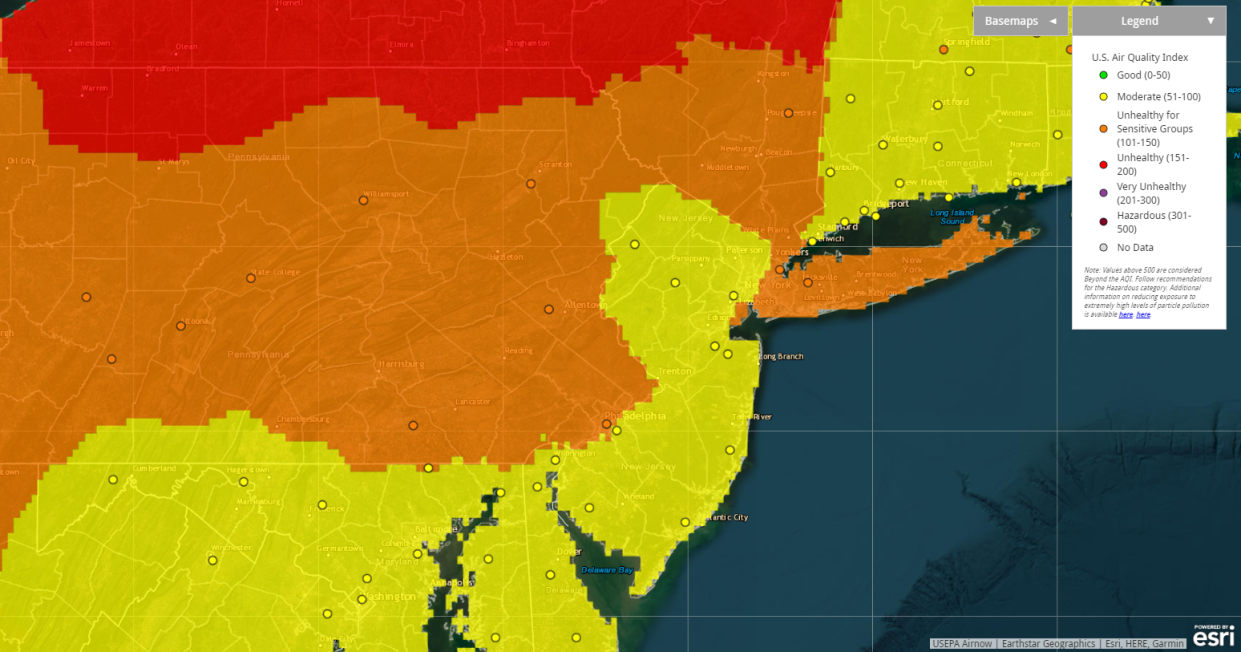Air quality index dropping as more wildfire smoke from Canada moves toward New Jersey

New Jersey's air quality is expected to dip into the "moderate" category beginning Monday as fine particulate pollution and ozone builds in the atmosphere across the region.
Traces of Canadian wildfire smoke are blowing across New Jersey and will continue through Tuesday. Northwesterly winds will carry smoke from Canadian wildfires into the Lower 48, resulting in air quality alerts for the northern High Plains, the Midwest, the Great Lakes, central Tennessee and North Carolina, and the Northeast. Smoke concentrations will diminish over parts of the Heartland on Tuesday, but may still cause moderately poor air quality along the East Coast.
Several monitoring stations in southern New Jersey fell into the moderate category Monday morning. "Moderate" levels of air pollution mean that people highly sensitive to air pollution could experience respiratory symptoms, according to the U.S. Environmental Protection Agency. A majority of people will feel no affects.
The smoke pollution contains microscopic particles of dirt and soot, which can get deep into human lungs and in some cases, the bloodstream, according to the U.S. Environmental Protection Agency. Exposure to high levels of particulate pollution can lead to heart attacks, irregular heartbeats, trigger asthma, decrease lung function and lead to premature death, according to the agency.
On the eastern side of the state, ground-level ozone will reach "moderate" levels in Monmouth and Ocean counties and along the Atlantic coast. Ozone forms when chemicals emitted from cars, factories and power plants mix and transform through chemical reactions with sunlight and heat, according to the EPA.
Ozone can be harmful and cause breathing problems, particularly in people with asthma, children and older adults, according to the agency.
Wildfire and smoke map
What to do when air quality is unhealthy
When air quality is unhealthy, it's important to take steps to protect yourself and your family. Here are some tips:
Stay indoors. This is the best way to avoid exposure to unhealthy air. If you must go outside, try to stay in areas with less pollution, such as parks or near water.
Avoid strenuous activity. When air quality is unhealthy, it's best to avoid activities that make you breathe harder, such as exercise or yard work.
If you have a medical condition, talk to your doctor. People with certain medical conditions, such as asthma or heart disease, may be more sensitive to unhealthy air. If you have a medical condition, talk to your doctor about how to protect yourself during times of poor air quality.
Check the air quality forecast. You can check the air quality forecast for your area online or on the radio. This will help you know when air quality is unhealthy and when you need to take steps to protect yourself.
Here are some additional tips for protecting yourself from unhealthy air:
Wear a mask. If you must go outside when air quality is unhealthy, wear a mask that can filter out pollutants.
Keep your windows closed. When air quality is unhealthy, it's best to keep your windows closed to keep polluted air out of your home.
Use an air purifier. If you have an air purifier, use it to help clean the air in your home.
Moisturize your skin. Unhealthy air can dry out your skin, so it's important to moisturize regularly.
Drink plenty of fluids. Staying hydrated can help your body flush out pollutants.
Most of our area will finally have a dry day with hazy sunshine. However, there may be a stray thunderstorm around the Poconos to Reading this evening, & there is a slight chance of a 'pop-up' storm near the shore this afternoon as the sea breeze develops. #njwx #pawx #dewx #mdwx pic.twitter.com/WXkfLjkVS7
— NWS Mount Holly (@NWS_MountHolly) July 17, 2023
What is normal air quality?
Normal air quality is air that is not polluted and does not pose a health risk to most people. The Air Quality Index (AQI) is a measure of air quality, and an AQI of 0 to 50 is considered to be good.
What is the AQI index?
The Air Quality Index is what the U.S. Department of Environmental Protection uses as a measure for air quality. It is a score that runs from 0 to 500 — the higher the number the worse the air quality — which is a representation of the number of pollutants in the lower atmosphere.
Here is how to read the categories for the AQI index:
Good: 0 to 50. Air quality is satisfactory and pollutants pose no risk
Moderate: 51 to 100. Air quality is acceptable. However, there may be a risk for some people, particularly those who are unusually sensitive to air pollution.
Unhealthy for Sensitive Groups: 101 to 150 Members of sensitive groups may experience health effects. The general public is less likely to be affected.
Unhealthy: 151 to 200. Some members of the general public may experience health effects; members of sensitive groups may experience more serious health effects.
Very Unhealthy: 201 to 300. Health alert: The risk of health effects is increased for everyone.
Hazardous: 301 and higher. Health warning of emergency conditions; everyone is more likely to be affected.
This article originally appeared on Asbury Park Press: Air quality map: Canada wildfire smoke returning to tri-state region

